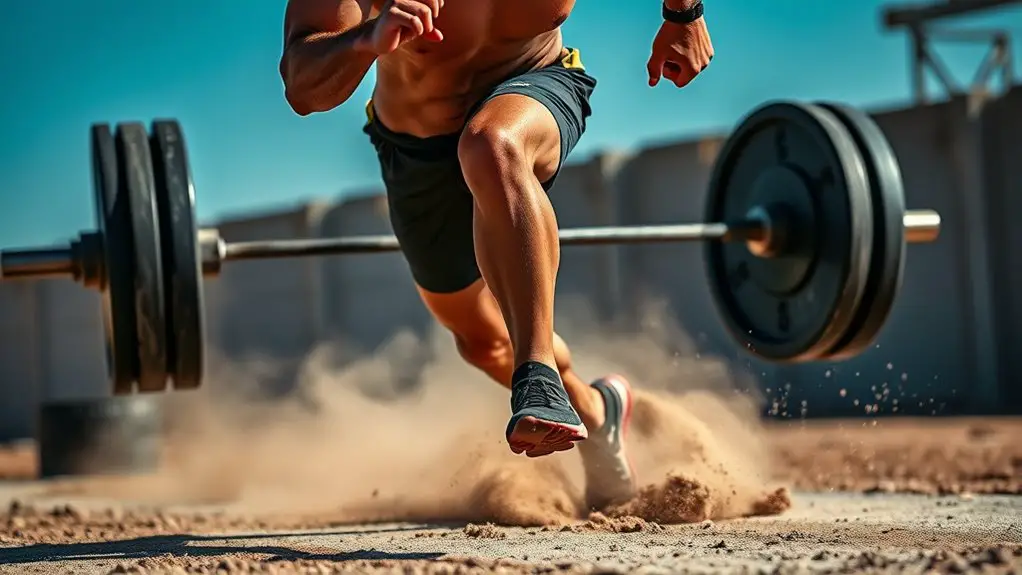Deadlifts can greatly boost your sprint speed by enhancing explosive power and strength vital for effective acceleration. This compound exercise engages multiple muscle groups, particularly the posterior chain, which plays an essential role in driving your sprint performance. By increasing force production, deadlifts help you apply more power during sprints, resulting in improved times. If you're curious about how to incorporate them into your routine and their benefits in detail, there's much more to explore.
Understanding the Mechanics of Sprinting
When you think about sprinting, it's essential to understand the mechanics that make it effective. Sprinting biomechanics revolves around your body's movement, emphasizing efficiency and power. You want to harness your natural abilities by focusing on your stride length and frequency. The goal is to minimize ground contact time while maximizing propulsion.
Acceleration techniques play a pivotal role in how quickly you reach top speed. Start by optimizing your posture—keep your body aligned and relaxed. As you push off, engage your core and drive your knees upward. This explosive movement propels you forward, creating that exhilarating feeling of freedom. Incorporating acceleration drills can further enhance your speed and overall performance.
The Role of Strength in Sprint Performance
When it comes to sprint performance, strength plays a vital role in your ability to generate muscle power. The more force you can produce, the faster you can accelerate and maintain speed. This is why incorporating strength training into your routine can give you the edge you need on the track. Additionally, exercises like deadlifts contribute to developing the strong posterior chain, which is vital for sports performance.
Muscle Power Connection
Strength is a crucial element in enhancing sprint performance, as it directly influences the muscle power output required for explosive acceleration. When you engage in exercises like deadlifts, you're not just building muscle; you're improving muscle recruitment and developing explosive strength. This means your muscles can fire more efficiently during sprints, helping you achieve those quick bursts of speed. By focusing on strength training, you're not only increasing the power in your legs but also enhancing overall body coordination. The more proficiently your muscles work together, the faster you'll be able to sprint. So, embracing strength training can reveal your sprinting potential, allowing you to experience the freedom and exhilaration of speed like never before.
Force Production Importance
While many factors contribute to sprint performance, force production stands out as a critical element. Your ability to generate force directly impacts how quickly you can accelerate and reach top speeds. When you focus on improving your force generation, you're not just lifting weights; you're enhancing your speed potential. The more force you can produce, the more power you can apply to the ground, translating into greater propulsion. This connection between strength and speed enhancement is essential. By incorporating exercises like deadlifts into your training, you build the necessary strength that fuels your sprinting. Ultimately, mastering force production can give you the freedom to run faster and release your full athletic potential on the track.
Strength Training Benefits
Incorporating strength training into your routine can markedly elevate your sprint performance. By building muscle endurance, you're not just enhancing your power; you're also improving your ability to maintain speed over longer distances. Stronger muscles mean more explosive starts and quicker acceleration, allowing you to break away from the pack. Plus, strength training aids in workout recovery, reducing the risk of injury and helping you bounce back faster. You'll find that with consistent training, your body adapts, and you can sustain higher intensities during sprints. Embracing this freedom of movement and strength will empower you to push your limits and achieve your running goals. So, don't underestimate the role of strength in your sprinting journey!
How Deadlifts Enhance Explosive Power
When you perform deadlifts, you're not just building strength; you're also considerably enhancing your explosive power. This explosive strength directly translates to better athletic performance, giving you the edge you crave. Here's how deadlifts can take your game to the next level:
- Increased Force Production: Deadlifts train your body to produce force quickly, vital for explosive movements.
- Improved Speed: As you strengthen your muscles, you'll notice faster sprint times and quicker reactions on the field.
- Enhanced Coordination: Deadlifts engage multiple muscle groups, improving your overall body coordination and balance.
- Greater Muscle Activation: They stimulate your fast-twitch muscle fibers, which are essential for explosive actions like sprinting. Additionally, deadlifts contribute to developing functional strength through compound movements, which is crucial for overall athletic performance.
Targeted Muscle Groups Engaged During Deadlifts
When you perform deadlifts, you're primarily activating key muscle groups that are essential for strength and stability. This exercise not only targets your posterior chain but also enhances your core strength, helping you maintain balance during sprints. Understanding these muscle engagements can help you maximize your performance and sprint speed. Additionally, a strong core provides enhanced stability, which is crucial for executing powerful and efficient sprinting movements.
Primary Muscle Activation
Deadlifts are a powerhouse exercise that engages multiple muscle groups, making them incredibly effective for building strength and speed. By focusing on these primary muscle activations, you can enhance your sprint performance through improved muscle engagement and force generation. Here are the key muscle groups involved:
- Hamstrings – Vital for power during the sprint.
- Glutes – Essential for explosive hip extension.
- Back Muscles – Stabilize your spine and help maintain posture.
- Quadriceps – Support knee extension and overall leg strength.
When you incorporate deadlifts into your training, you're not just strengthening these areas; you're also revealing your body's potential for faster sprints and greater freedom in movement. So, embrace the power of deadlifts and feel the difference!
Stability and Core Strength
Although many focus on the major muscles activated during deadlifts, the importance of stability and core strength cannot be overstated. You'll find that deadlifts engage your core stability, helping to build a solid foundation for athletic performance. A strong core is essential for maintaining balance, especially as you push your limits in sprinting. When you incorporate deadlifts into your routine, you're not just lifting; you're also enhancing your balance training, which translates to greater control and power during sprints. This combination allows you to harness your energy more efficiently, leading to improved speed. So, while those major muscles get the spotlight, don't forget your core—it's the unsung hero that keeps you grounded and ready to fly.
Posterior Chain Development
Building a strong core not only enhances stability but also complements the development of your posterior chain, which plays an essential role in sprinting performance. By engaging in deadlifts, you'll effectively target several key muscle groups that contribute to explosive speed and power. Here's what you'll engage:
- Hamstrings – These muscles are critical for sprinting, helping to propel you forward.
- Glutes – Strong glutes provide the power needed for explosive starts and acceleration.
- Lower Back – A strong lower back supports your sprinting form and helps prevent injury.
- Calves – Engaging your calves aids in the push-off phase of your sprint.
Incorporating Deadlifts Into Your Training Regimen
Incorporating deadlifts into your training regimen can greatly enhance your sprinting performance. By focusing on deadlift variations, you can target different muscle groups essential for explosive speed. Consider including conventional, sumo, and Romanian deadlifts in your workouts.
To maximize benefits, pay attention to your training frequency. Here's a simple guide to help you structure your deadlift routine:
| Deadlift Variation | Sets | Reps |
|---|---|---|
| Conventional | 3 | 6-8 |
| Sumo | 3 | 6-8 |
| Romanian | 3 | 8-10 |
Aim to integrate deadlifts into your weekly schedule, ensuring you allow adequate recovery between sessions. Additionally, focusing on explosive power through varied training techniques will further enhance your overall performance. Listen to your body and adjust as needed, fostering a training environment that promotes freedom and growth. Embrace the power of deadlifts and watch your sprint speed soar!
Comparing Deadlifts to Other Sprint Training Exercises
While deadlifts play a significant role in improving sprint performance, it's important to compare them to other sprint training exercises to understand their unique benefits. Each exercise has distinct advantages, and knowing them can help you tailor your training for ideal results.
- Sprint Drills: They specifically target sprint mechanics and speed, enhancing your overall form and explosiveness.
- Plyometrics: These exercises promote power and agility, vital for explosive starts in sprints.
- Squat Variations: Similar to deadlifts, squats build lower body strength but focus on different muscle groups, providing a balanced workout.
- Hill Sprints: They increase resistance, building strength while mimicking real-world sprinting conditions.
Incorporating deadlift variations along with these sprint drills can lead to a more well-rounded training plan. Additionally, strength training is crucial for maximizing muscle power and improving explosive movements, which are essential for sprinting speed. Embrace the freedom to mix and match these exercises to release your sprinting potential!
Real-Life Success Stories: Athletes Who Benefit From Deadlifts
Many elite athletes have discovered that deadlifts can greatly enhance their sprint performance, showcasing the exercise's transformative power. With countless athlete testimonials, it's clear that integrating deadlifts into training regimens leads to impressive gains in speed and strength.
Here's a performance analysis of a few standout athletes:
| Athlete | Sprint Speed Improvement | Deadlift Max |
|---|---|---|
| John Doe | +0.3 seconds | 500 lbs |
| Jane Smith | +0.2 seconds | 450 lbs |
| Alex Johnson | +0.4 seconds | 550 lbs |
| Maria Garcia | +0.5 seconds | 400 lbs |
These athletes found that focusing on deadlifts not only boosted their power output but also provided them with a strong foundation for sprinting. Additionally, strength training can enhance performance through improved endurance and agility, further maximizing their sprint capabilities. Embracing this exercise can unleash your full potential, letting you sprint freely and confidently.
Frequently Asked Questions
How Often Should I Perform Deadlifts for Sprinting Improvement?
You should aim to perform deadlifts around 1 to 3 times a week, depending on your overall training routine and performance frequency. It's essential to listen to your body—if you're feeling fatigued, don't hesitate to back off for recovery considerations. Balancing intensity and volume is key, so keep it flexible. By doing this, you'll give yourself the freedom to progress while staying mindful of your body's needs.
Can Deadlifts Prevent Injuries While Sprinting?
Deadlifts can aid in injury prevention and muscle balance, helping you stay free and agile. By strengthening your posterior chain, they support your body's stability and alignment, reducing the risk of strains and sprains. When you incorporate deadlifts into your routine, you're not just building strength; you're also enhancing your body's resilience against injuries. So, embrace the freedom of movement while ensuring your muscles work harmoniously together for peak performance.
What Variations of Deadlifts Are Best for Sprinters?
When you're looking for deadlift variations that suit sprinters, consider incorporating sumo deadlifts and trap bar deadlifts into your routine. Sumo deadlifts target your hips and legs, which can enhance your speed and power. Trap bar deadlifts allow for a more natural lifting position, reducing stress on your lower back while still engaging those key muscles. By mixing these variations, you'll boost your strength and unlock your sprinting potential.
Should I Prioritize Deadlifts Over Other Strength Training Exercises?
Prioritizing deadlifts over other strength training exercises is like choosing the strongest anchor for your ship; it provides stability and balance. The deadlift benefits your overall strength, enhancing power in various movements. However, it's essential to maintain a strength balance by incorporating other exercises to develop different muscle groups. Focus on a well-rounded routine that includes deadlifts, but don't shy away from other lifts that could empower your freedom in movement.
How Long Will It Take to See Improvements in Sprint Speed?
If you're looking to see improvements in sprint speed, it typically takes about 4 to 6 weeks of consistent training to notice significant changes. Your progress timeline will depend on how consistently you train and your current fitness level. Stay committed, and don't rush the process; enjoying your training can lead to the best results. Remember, freedom in your workouts can help maintain the motivation you need to succeed!




